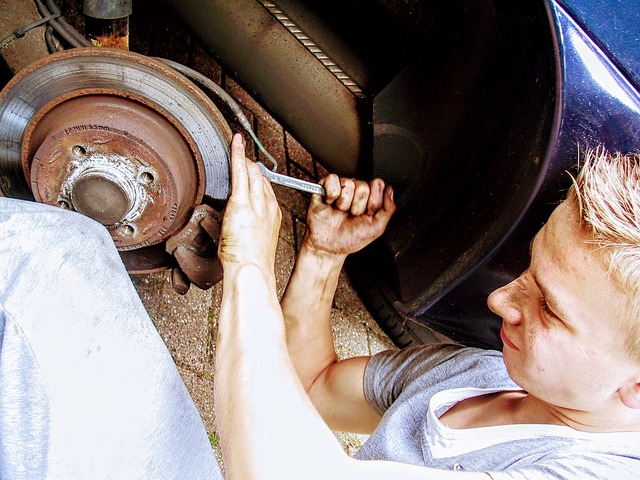Concrete foundations face age-related and environmental challenges that can compromise structural integrity. Early detection is crucial for effective repair, preserving longevity. Professional inspectors use visual exams and advanced tools like moisture meters and GPR to pinpoint issues. Repairs range from filling minor cracks to structural bracing or foundation replacement. Tailored methods address root causes—settlement, soil shifts, water damage. DIY repairs are suitable for minor cracks but extensive damage requires specialists. Material choice depends on damage type, weather, traffic load, and colour matching. Regular inspections and preventive measures like drainage, waterproof membranes, and crack sealing are essential to avoid costly Concrete Repair.
“A sturdy foundation is the backbone of any structure, and concrete foundations, prevalent in many homes, require regular inspection and maintenance. This comprehensive guide delves into the intricacies of concrete repair, addressing common damage types and offering practical solutions. From identifying crack patterns to choosing the right restoration materials, you’ll navigate the process like a pro. Learn when professional intervention is necessary and discover preventive measures to fortify your foundation against future deterioration, ensuring longevity and stability.”
Understanding Concrete Foundation Damage: Common Issues

Concrete foundations, though sturdy, are susceptible to various issues over time, leading to damage that requires attention and concrete repair solutions. Some common problems include cracks, which can be caused by shifting soil, poor construction, or aging; these cracks may appear as hairline fractures or wider, structural gaps. Settling or sinking of the foundation is another issue, often occurring due to improper soil compaction or changes in moisture levels, resulting in uneven floors and walls.
Blisters or bulges in the concrete can form due to internal pressure or external forces, indicating potential structural weaknesses. Water infiltration is a significant concern, as it can lead to corrosion of steel reinforcement bars and accelerate concrete degradation. Prompt identification of these issues is crucial for effective concrete repair, ensuring the longevity and stability of the foundation.
Methods for Inspecting Foundation Integrity

Inspecting foundation integrity is a crucial step in maintaining or repairing any structure, especially older homes. Professional inspectors use several methods to assess concrete repair needs effectively. One common technique involves visual examination, where experts carefully inspect the foundation for cracks, uneven surfaces, or signs of water damage. This initial step provides valuable insights into potential issues.
Additionally, they may employ advanced technologies such as moisture meters and ground-penetrating radar (GPR). Moisture meters help identify areas with excessive humidity, which could indicate structural problems, while GPR offers a non-invasive way to scan the foundation for cracks, voids, or other defects beneath the surface. These comprehensive approaches ensure that any concrete repair work is accurately targeted, addressing the root causes of foundation instability.
Evaluating the Extent of Concrete Repair Needed

When assessing a foundation for repair, evaluating the extent of concrete repair needed is crucial. This involves meticulous inspection to identify damages such as cracks, bulges, or uneven surfaces. By closely examining both the interior and exterior of the foundation, professionals can determine the severity of the issue. Cracks, for instance, may be superficial or indicative of more profound structural problems beneath the surface.
The evaluation process includes documenting the size, width, and pattern of cracks, as well as any signs of settlement or shifting in the foundation walls. This data is critical in recommending the appropriate Concrete Repair methods. Minor cracks might only require filling and sealing, while extensive damage may necessitate more substantial interventions like structural bracing or even full-scale foundation replacement.
Techniques for Fixing Cracks and Deterioration

When addressing cracks and deterioration in concrete foundations, there are several effective techniques for repair. The first step involves identifying the root cause of the damage, whether it’s due to settling, shifting soil, or water intrusion. Once the source is determined, professionals can employ tailored methods for concrete repair. This may include structural stabilization techniques like carbon fiber wrapping or steel bracing for more severe cases.
For smaller cracks and surface-level deterioration, a process known as epoxy injection is commonly used. This involves drilling into the crack and injecting a specialized epoxy resin that fills and strengthens the void. Another popular method is carbon fiber patching, where thin sheets of carbon fiber are applied over cracks to create a durable, non-porous barrier. These techniques offer long-lasting solutions, ensuring the foundation’s structural integrity and preventing further damage from occurring.
When to Consider Professional Concrete Restoration

If you notice cracks, heaves, or uneven surfaces in your concrete foundation, it might be time to consider professional concrete restoration. While minor issues can sometimes be addressed with DIY methods, more severe damage requires expert intervention. Professional concrete restoration specialists have the tools and expertise to assess the extent of the problem and implement effective solutions. They can perform structural repairs, stabilize shifting foundations, and even completely restore damaged concrete to its original condition.
Regular foundation inspections are crucial in identifying potential problems early on. Over time, various factors like weather conditions, soil settlement, or faulty construction can take a toll on your foundation. By hiring professionals for concrete repair, you ensure that any issues are addressed promptly, preventing further deterioration and costly repairs down the line.
Choosing the Right Materials for Concrete Repair

When undertaking concrete repair, selecting the appropriate materials is a crucial step in ensuring long-lasting and effective results. The market offers various options tailored for different types of damage and environmental conditions. For instance, epoxy injections are ideal for repairing cracks, offering high strength and resistance to corrosion. On the other hand, hydraulic cement, with its quick-setting properties, is perfect for rapid repairs and filling gaps.
Consideration should also be given to factors like weather conditions and traffic load, as these influence material choice. Choosing materials that match the existing concrete in terms of colour and texture helps maintain the aesthetic appeal of structures. Additionally, using products designed for specific repair tasks, such as repairing structural damage or sealing joints, guarantees better performance and longevity of the repair work.
Step-by-Step Guide: Performing DIY Concrete Repairs

Performing DIY concrete repairs can be a cost-effective way to maintain and enhance your property. Here’s a step-by-step guide for tackling common concrete issues at home:
1. Identify the Damage: Start by thoroughly inspecting the damaged area. Concrete cracks, chips, or holes are typical issues. Note their size and depth as this will guide your repair process.
2. Gather Materials: Collect the necessary tools and materials, including a wire brush, chisel (for deep cracks), concrete patch compound or mortar mix, sand, water, a trowel, and protective gear. Ensure you have enough supplies to cover the damaged area adequately.
3. Clean the Surface: Remove any debris, loose particles, and vegetation from the repair site. Use the wire brush to scrub the surface, ensuring it’s clean and free of contaminants. This step is crucial for a strong bond between the patch and existing concrete.
4. Prepare the Patch: If repairing a crack, use the chisel to widen and clean out the crack, creating a depth that allows for better compound penetration. For larger holes, cut out the damaged section using a saw or chisel.
5. Mix and Apply: Follow the instructions on your chosen patch compound or mortar mix. Typically, you’ll need to blend sand and water with the powder to create a thick paste. Use the trowel to apply the mixture, filling in the crack or hole evenly. Smooth the surface for a seamless finish.
Preventive Measures: Strengthening Your Foundation

Preventive measures are essential for maintaining a solid foundation and avoiding costly concrete repair in the long run. Regular inspection is the first step; homeowners should periodically check their foundation for any signs of damage, such as cracks, uneven floors, or bulging walls. Addressing these issues early can prevent further deterioration.
Strengthening your foundation involves several strategies. One effective method is to ensure proper drainage around the property, preventing water from pooling near the base of the structure. Additionally, applying a waterproof membrane during construction or repairing and sealing existing cracks can ward off moisture intrusion, which is a common cause of concrete damage. Regular maintenance, including cleaning out gutters and downspouts, also contributes to a healthy foundation.
